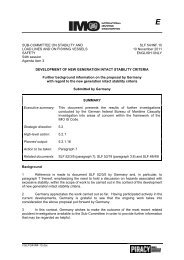Examination of the intact stability and the seakeeping behaviour
Examination of the intact stability and the seakeeping behaviour
Examination of the intact stability and the seakeeping behaviour
You also want an ePaper? Increase the reach of your titles
YUMPU automatically turns print PDFs into web optimized ePapers that Google loves.
5 Evaluation<br />
Based on <strong>the</strong> determination <strong>of</strong> <strong>the</strong> <strong>seakeeping</strong> behavior in <strong>the</strong> previous chapter, <strong>the</strong> following<br />
sections summarize <strong>and</strong> explain <strong>the</strong> results, highlight <strong>the</strong> consequences <strong>and</strong> give recommendations<br />
for fur<strong>the</strong>r detailed examinations also carried out in <strong>the</strong> scope <strong>of</strong> this <strong>the</strong>sis.<br />
5.1 Results<br />
The examination includes only container vessels, which are altoge<strong>the</strong>r ra<strong>the</strong>r similar in terms <strong>of</strong><br />
hull form <strong>and</strong> ship design. This is due to <strong>the</strong> necessity to carry as much containers as possible<br />
on a vessel in combination with relatively high speed requirements (> 20 kts). All vessels have,<br />
more or less, a distinctive bow are <strong>and</strong> a ne shaped hull form compared to o<strong>the</strong>r ship types<br />
(e.g. bulkers or tankers). This is expressed by c B values in a scope <strong>of</strong> 0.57 ... 0.69.<br />
The results show, that <strong>the</strong> transversal accelerations on <strong>the</strong> bridges are correlated with <strong>the</strong><br />
respective rolling angles. Therewith it is not implied, that one explicit rolling angle always<br />
causes one explicit acceleration. But it can be stated, that high accelerations only occur in<br />
combination with large rolling angles.<br />
Summing up <strong>the</strong> results <strong>of</strong> <strong>the</strong> examination <strong>of</strong> <strong>the</strong> single ships in <strong>the</strong> ballast arrival loading<br />
condition reveals:<br />
ˆ In <strong>the</strong>ir ballast arrival loading condition all examined ships have, more or less, a GM value,<br />
which is signicantly higher than <strong>the</strong> required minimum GM min according to <strong>the</strong> rules <strong>of</strong><br />
<strong>the</strong> IMO[4]. It can be stated, that all vessels considered have a very high <strong>stability</strong>.<br />
ˆ Most vessels experience large rolling angles up to 40 ◦ <strong>and</strong> high transversal accelerations on<br />
<strong>the</strong> bridge up to 15 m /s 2 , depending on <strong>the</strong> examined accident situation named in chapter<br />
3.12.<br />
To get an overview <strong>of</strong> <strong>the</strong> examination, all calculated transversal acceleration on <strong>the</strong> bridge<br />
against <strong>the</strong>ir respective GM solid are plotted in gure 5.1. The numbers in gure 5.1 represent<br />
<strong>the</strong> respective vessels in chapter 4. At this, <strong>the</strong> maximum transversal acceleration is plotted for<br />
each <strong>of</strong> <strong>the</strong> three accident situations. For better comparison <strong>of</strong> <strong>the</strong> occurring accelerations, two<br />
<strong>of</strong> <strong>the</strong> vessels in accident are considered, too. The Chicago Express (abbreviated with CE)<br />
<strong>and</strong> <strong>the</strong> 2468 TEU Vessel in <strong>the</strong>ir respective accidental loading condition are added to <strong>the</strong><br />
graph for each <strong>of</strong> <strong>the</strong> three analysed accident situations.<br />
43

















